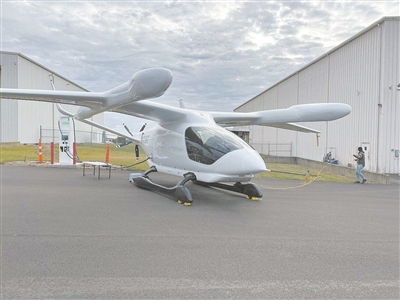The first manned flight of Japan's "flying car" was successful, and it is planned to be put into commercial use in 2025
[ Time:2023-02-24 Number of views:325]
【 World tide of scientific and technological Innovation 】
"Flying cars" are widely seen as the next generation of transportation. The first outdoor manned test flight took place in Oita city in southwestern Japan on February 17, bringing the new vehicle one step closer to "flying" to reality.
The test flight was led by the Okayamakura Shikushima Aerospace Industry Research Institute (MASC), a private group. Nikkei Asian Review said the successful test flight was a major step forward for a technology seen as serving remote islands and mountainous areas lacking transportation.
However, MASC is not the only group in Japan responsible for flying and other businesses, Japan's All Nippon Airways Holding Company, Japan Airlines and other companies are further developing "flying cars". Nor is Japan the only country dabbling in the blue ocean market for "flying cars." Companies around the world are already competing around this new direction of mobility change.

Japan's two-seater "flying car" was successfully tested on February 17. Photo credit: Nikkei Asian Review
Japan's first manned flight was successful
According to the Japan Times, about 400 people gathered at Tanura Beach in Oita City to watch the test flight of the "flying car", which is the first manned outdoor flight approved by Japan's Ministry of Land, Transport and Tourism.
After rising to an altitude of about 30 meters above the ground, the "flying car" circled at a speed of 36 kilometers per hour, and the flight lasted about 3.5 minutes.
The "flying car", which can carry two passengers, was tested using a Chinese-made two-seater "flying car" based on drone technology.
"The flight was comfortable, without any shaking, and only a slight vibration was felt during the hover." "The flight was like sitting in a car," said MASC Chairman Koji Kirino, who was riding in the flying car.
Oita Mayor Kiichiro Sato said that from a technical point of view, "flying cars" have reached a point where they can be put into practical use. He called for the "flying car" to be put into commercial use in Oita by 2025.
Japan is aiming for the country's first commercial flight of a "flying car" at Expo 2025 in Osaka. In addition, the Japanese government will create a new pilot license for "flying cars" and a license for mechanics to repair "flying cars."

The United States tests electric air taxis. Photo credit: US air services company BladeAirMobility
The United States tests electric air taxis
Us aviation services company Blade Air Mobility has conducted the first test flight of an electric vertical take-off and landing (eVTOL) aircraft in partnership with Beta Technologies, developer of the next generation sustainable Alia-250 aircraft.
Blade CEO Rob Wiesenthal described the test flight as "an important milestone in the transition from helicopters to electric vertical aircraft."
Blade aims to launch eVTOL flights in 2025, all-electric aircraft that will be owned and operated by its operating partners, with Beta providing charging infrastructure in multiple locations.
The Alia-250 is known for its near-silent flight. Blade chief technology Officer Brandon Keane said the plane can take off and land like a helicopter, with lifting rotors on its wings, but it can cruise no faster than an airplane.
The Alia-250 can be fully charged in 50 minutes, and when fully charged, the aircraft can carry a pilot and five passengers for about 460 kilometers. Its noise level is only one-tenth that of a typical rotorcraft.

On February 22, Australia's highly efficient long-range eVTOL aircraft Vertiia successfully completed its first test flight. Photo credit: Australian Green Aerospace company AMSLAero
Australian Vertiia completes first flight
Australian green aerospace company AMSL Aero has announced that its highly efficient long-range eVTOL aircraft Vertiia has successfully completed its first test flight.
The aircraft, in strict compliance with Australian Civil Aviation Safety Authority (CASA) regulations, completed the mooring hover over the central west of New South Wales by remote control. The flight is an important milestone for zero-emission aircraft.
Vertiia can fly up to 1,000 kilometers, three times the range of any eVTOL aircraft. The company expects to begin delivering products to customers in the aeromedicine, cargo, emergency and regional air traffic sectors in 2026 after certification, which will make medical services more accessible in remote areas and bring new modes of care to local populations.
CEO Andrew Moore said Vertiia's unique "box wing" design is based on the box kite, which was invented nearly 130 years ago by Australian aviation pioneer Lawrence Hargrave.
"When Vertiia goes up, we feel the adrenaline rush." Moore said the Vertiia prototype flew better than they expected, and the flight was smooth and enjoyable.
The company will now conduct more test flights and begin CASA certification, and Vertiia will also be on display at the Aerospace and Defence Exhibition in Melbourne, Australia, from February 28 to March 5, 2023.